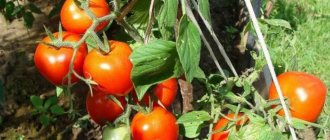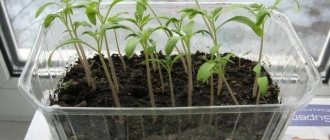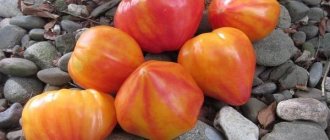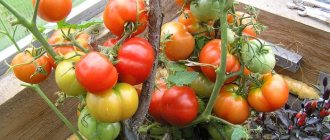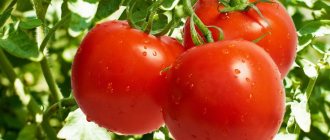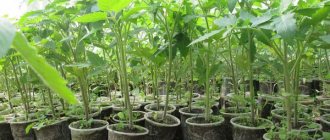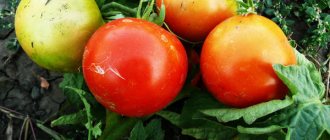Description of the variety
The Volgograd early ripening variety 323 (state register) was developed by crossing Bush Beefstrek and Local crops in 1973. Breeders recommend the variety for cultivation in open ground in the Lower Volga and Central Black Earth regions. In the Urals and Siberia, Volgograd early ripening 323 is recommended to be grown in greenhouse conditions.
Distinctive features
Volgograd early ripening 323 has the following properties:
- early ripening variety (90-100 days);
- determinate type plant - does not require pinching the top to stop growth;
- powerful root system;
- low lush bushes (from 25 to 45 cm);
- leaves are light green, wrinkled, with slight pubescence;
- the first ovary is formed above the 6-7th leaf, then with an interval of 1 leaf;
- inflorescences are simple, intermediate type, bearing up to 6 flowers.
In the State Register of Varietal Achievements there is a variety with a similar name - Volgogradsky 5/95. This culture was bred in 1953 and has slightly different characteristics.
Basic indicators:
- mid-ripening (ripens in 120-130 days);
- suitable for growing in open ground;
- has taller standard-type bushes (70-100 cm);
- produces large fruits (weight reaches 150 g);
- has an intense red color of the fruit;
- has a high yield - up to 10 kg/m2.
Fruit characteristics, yield
The fruits are round in shape, slightly flattened at the ends, red with an orange tint. The tomato skin is thin, dense and shiny. The pulp is juicy, fleshy, sweet.
The average diameter of tomatoes is 7 cm, weight reaches 100 g. Productivity is 4-7 kg/m2.
Characteristics
The variety was developed thanks to work on crossing several varieties ("Local", "Bush Beefstek") by scientists at the Volgograd Experimental Station VIR. Registered in the State Register for the Central Black Earth and Lower Volga regions for cultivation in open ground in 1973. The most favorable regions for this variety will be the Central and Volgograd, Nizhnevolzhsky districts, but cultivation is possible throughout the Russian Federation and nearby countries.
The variety is universal, suitable for fresh consumption, salads, hot dishes, and freezing. The taste of tomatoes is sweet with minimal sourness characteristic of tomatoes. Tomatoes do not lose nutrients during hot processing. The sugar content in Volgogradsky early ripening 323 is about 4%. Canning and pickling of whole fruits goes well; due to their dense consistency, the tomatoes do not lose their shape in jars during long-term storage.
Suitable for the production of sauces, ketchups, tomato paste and juices. But the juice from this variety will be very thick. The yield of the variety is good, up to 8 kg per 1 sq. m. From one plant you can collect about 6 kg in a good season. The medium-sized fruits ripen almost simultaneously, have an excellent shape, and are suitable for sale.
You can compare the yield of this variety with others in the table below:
| Variety name | Productivity |
| Volgograd early ripening | up to 8 kg per square meter |
| De Barao | up to 40 kg per square meter |
| Visibly-invisibly | 12-15 kg per square meter |
| Apples in the snow | 2.5 kg per bush |
| Early love | 2 kg per bush |
| Samara | up to 6 kg per square meter |
| Podsinsky miracle | 11-13 kg per square meter |
| Baron | 6-8 kg per bush |
| Yablonka Russia | 3-5 kg per bush |
| Cranberries in sugar | 2.6-2.8 kg per square meter |
| Valentina | 10-12 kg per bush |
How to grow seedlings
For Volgograd early ripening 323, the seedling method of cultivation is preferable, although direct sowing in the ground is also allowed in the southern regions after the May holidays. Depending on climatic conditions, the summer resident himself decides where he will grow tomatoes - in open or protected ground.
Seed preparation
The seeds of the variety have almost 100% germination and do not require special pre-sowing preparation. You can speed up the germination process by soaking it in a gauze cloth moistened with a weak solution of potassium permanganate for 24 hours.
Container and soil
Any low and wide containers that you have on hand are suitable for sowing.
Tomatoes are demanding on fertility and water-air exchange in the soil. You can buy the substrate for sowing ready-made or prepare it yourself:
- peat - 1 bucket;
- humus - 2 buckets;
- sand - 0.5 buckets.
Add 1 tsp to this mixture. superphosphate, 1 tsp. potassium sulfate and a third of a bucket of wood ash. This soil is slightly acidic in composition, rich in mineral compounds and organic matter, and has good air permeability.
Attention ! Before sowing seeds, the soil needs preventive treatment. The best treatment method is watering with a strong solution of potassium permanganate or biological preparations Fitosporin-M or Trichodermin.
Sowing
Prepared seeds are sown in containers filled with moist soil to a depth of 1.5 cm, the distance between plants is 2-4 cm, between rows - 2 cm. The crops are covered with the same fertile soil and moistened again. The boxes are covered with film to create a greenhouse effect.
Optimal conditions for seed germination:
- temperature 22-25 °C;
- humidity 75%.
The timing of sowing seeds depends on the location of further cultivation of tomatoes:
- for heated greenhouses - February;
- for film greenhouses and greenhouses - the third ten days of March;
- in open ground - 1-2 weeks of April.
Growing and care
As soon as the shoots appear (after 4-5 days), the young seedlings are freed from the film and placed in a well-lit place. Watering should be regular. Seedlings that have not shed their cotyledon leaves are plucked off by hand.
Temperature for normal development of seedlings:
- daytime - 15-20 °C;
- night - 8-12 °C.
Like adult tomatoes, seedlings are fed. Fertilizing with complex mineral fertilizers once every 2 weeks (Kemira Lux, Mortar A) has worked well.
2 weeks before planting, the seedlings are hardened off. If tomatoes are grown in apartment conditions, then arrange through ventilation of the room. If possible, the plants are taken out onto the balcony. When the seedlings reach a height of 15-20 cm, they are planted in open ground.
Important ! If the seedlings have stretched out, they can be saved by picking them into tall glasses with the root collar buried.
The emergence of difficulties
Growing tomatoes is not difficult. But sometimes the Volgograd variety can cause some trouble.
- Don't overdo it with watering. Wetting the soil daily can lead to the development of a fungal disease. The blackleg disease, which is common among tomatoes, can destroy the entire crop, therefore, it is necessary to spray the plants with fungicides in time.
- If you sow seeds too early, you may experience stretching of seedlings. The problem is caused by cramped containers and lack of light. Planting it in a permanent place can save the situation.
- It happens that a seedling breaks. Don't throw it away right away. It is worth separating the bad roots and planting the plant in a glass of water for several days. The field of this sprout can be returned to the ground again.
- When the air temperature is hot or during long rainy days, the plant stops developing and becomes susceptible to disease.
The Volgograd tomato pleases with a high yield. If you familiarize yourself with all the features of growing and caring for a plant, you can avoid mistakes and invest a minimum of effort.
How to grow tomatoes
The seedlings are planted in a permanent place at the age of 60 days. For the health of tomatoes, seedlings are not planted the next year after any nightshades. The best predecessors in the garden are cabbage and onions of various types.
Landing
Tomatoes Volgograd early ripening 323 are planted in a prepared bed.
Step-by-step planting technology:
- The holes are prepared deep and wide.
- Plants 20 cm in height are planted one at a time in a hole, at the bottom of which a handful of superphosphate is poured.
- Planting pattern: distance between plants - 40 cm, between rows - 50 cm.
- The soil is added to the first leaves on the trunk.
- A small ditch is created around each plant for quality watering.
- Water generously.
Reference ! The use of the immunomodulator and growth stimulator "Zircon" will speed up the survival and adaptation of seedlings to a new place.
Care
Tomato care measures:
- Watering once every 10-15 days with settled water at room temperature. Excessive soil moisture can lead to fungal diseases and root rot. It is important to water the plants generously and then wait a period of time until the soil dries out.
- Regular weeding as weeds grow.
- Loosening is combined with watering.
- Pinching of Volgograd early ripening 323 is not required. To increase the mass of fruits, you can remove each stepson up to 1 cluster.
- Shaping the bush. In determinate tomatoes, bushes are formed into 2-3 stems, removing excess shoots. The lower large leaves are also removed. Removal of stepsons is carried out in cloudy weather.
- Plants do not require staking.
- To obtain a high-quality harvest, regular feeding is important - once every 10 days. It is recommended to alternate organic and mineral fertilizers.
Features of cultivation and possible difficulties
Volgograd early ripening 323 is an unpretentious crop. The only difficulties that may arise when growing it are waterlogging of the soil and lack of nutrition. These factors can be easily eliminated by correcting agricultural practices.
Diseases and pests
The variety has fixed resistance to late blight, anthracnose, cladosporiosis, blight and rot.
If the weather is damp in the summer, to prevent fungal diseases, the greenhouses are regularly ventilated, and the plantings are treated with copper preparations (copper sulfate, “HOM”).
Harvesting
Soon the time will come to harvest, which will delight you with the Volgograd early ripening tomato 323. Reviews indicate that many gardeners give preference to it or grow it in their beds along with other tomatoes.
To speed up the ripening of tomatoes, do not wait until they are completely ripe. As soon as they turn brown, they are plucked from the bush and laid out in a sunny place. In a week the tomatoes will be ripe and tasty. Just like those that ripened on the bush. But you shouldn’t do this with green tomatoes. Such fruits will be tasteless, even if they turn red.
Tomato Volgograd early ripening 323 is the leader among non-hybrid varieties.
Advantages and disadvantages of the variety
Volgograd early ripening 323 has a lot of useful qualities:
- precocity;
- productivity;
- does not require pinching;
- adapted to temperature changes;
- Resistant to major nightshade diseases.
No significant deficiencies were identified in the variety. The plant reacts to extreme heat by reducing the ovaries. This property is due to the physiology of the plant, since when exposed to high temperatures, pollen becomes sterile.
Variety selection
The choice of varieties is of great importance. The place where the tomatoes will grow, the area, ventilation and shade, and soil are taken into account. Even how often you visit your garden.
If the area is small, near the house, and poorly ventilated, then tall varieties will grow and bear fruit there normally (subject to regular tying, pinching, and processing). In a large garden, where there is room for tomatoes, they are well ventilated, which means they are less damaged by diseases. Determinate varieties can be placed here. These are low-growing plants that do not require staking. This tomato will grow even without special care.
To get ripe tomatoes at the end of June, you need to plant early varieties. Their ripening period is about 100 days. Another point is a hybrid or an old proven variety. Farmers and wholesale producers prefer to grow hybrids. They provide a guaranteed harvest and are not damaged by diseases. But you should not collect seeds from them. It will not be possible to grow delicious tomatoes from them next year.
Many gardeners continue to grow tomatoes of old and relatively old varieties. One of them is the Volgogradsky tomato (old variety) and the relatively old Volgogradsky early ripening tomato 323. Reviews from people who grow these tomatoes indicate that they are worthy of attention.
Farmer reviews
Several reviews from gardeners about this reliable and popular variety.
Elena, Samara region: “Of all the tomatoes that I planted, only this one turned out. The downside is that the taste is typical for sophisticated people, the appearance of the tomatoes is uninteresting, however, the same as in the photo on the packaging.”
Nikita Vladimirovich, Zelenograd: “I’ve been growing it for 3 years now. I go to the dacha once a week. This variety was a godsend for me! Grows without any problems. You can water once a week.”
Marina, Kherson: “The endurance of plants is amazing. I grow it in open ground. One day I was in a hurry to plant seedlings, and they got frostbitten. I thought they would die. But the plants grew back and gave a good harvest.”
Agrotechnics of cultivation and care
Basically, Volgograd early ripening tomato 323 is grown by amateur vegetable growers in film greenhouses or greenhouses. Plants can be planted in them as early as mid-May. Based on this, we determine the time for planting seeds for seedlings. Early ripening tomatoes begin to be sown 50-60 days before planting in the ground. For the middle zone it will be the beginning of March.
Growing seedlings
An important component when growing tomato seedlings is soil preparation. You can cook it yourself. You will know exactly what the soil mixture consists of and prevent the entry of harmful impurities and bacteria. The following composition would be good:
- sand 25%;
- land - 30%;
- high-moor peat or humus – 45%.
Add 1 tsp per bucket of soil mixture. potassium sulfate and superphosphate, as well as a glass of ash. Soil purchased in a store, as well as prepared independently, should be subjected to heat treatment, and also spilled with a solution of potassium permanganate to destroy pest larvae and pathogenic bacteria.
Seeds should be planted in a flat container no more than 7 cm high or in individual cups. In boxes filled with soil (it must be moist and compacted), furrows are made at a distance of about 5-7 cm from each other and a depth of 1-1.5 cm. Tomato seeds are laid out dry, since they germinate well, at a distance of 2 cm from each other. Sprinkle with soil and compact. The container is covered with film and kept in a warm place at a temperature of at least 25 °C.
When mass shoots appear, the film is removed and the temperature is reduced to 16–18 °C for a week. Thanks to this, the seedlings will become stronger and develop a better root system. Afterwards the temperature can be increased again.
The seedlings will immediately need good illumination from 12 to 14 hours; in the case of shorter daylight hours, the plants are illuminated with photo lamps or fluorescent lamps. The growth and strength of the seedlings will depend on this. Picking will definitely be required when 2 true leaves appear.
Seedlings are fertilized several times. The first is 7-9 days after picking, the second - when the 3rd true leaf appears, the third - after the 5th leaf. To do this, use ready-made complex fertilizers, diluting them with water in the concentration indicated on the package.
Tomatoes should not be over-watered. This causes rot and a disease called blackleg. The plant may die. It is useful to combine watering with the application of liquid fertilizers. Seedlings should be watered moderately, the soil should be only slightly moist.
Transplanting
With the onset of stable warmth, seedlings of early ripening tomatoes are planted. Seedlings must be no older than 65 days.
The bush of this tomato variety is not tall, so the planting pattern is 50x40 cm. The holes are made deep; a seedling with a lump of earth should fit in them. First, pour water into the hole and add a spoonful of superphosphate. Afterwards, the seedlings are buried up to the cotyledon leaves and the soil is compacted around the seedling.
Watering and fertilizing
When growing tomatoes, it is better to combine these actions. Water the plants every week with a fertilizer solution. First, a liter of water is poured under each bush, then 0.5 liters of solution, then water again. This is the composition proposed by G. Kizima:
- 2 tbsp. spoons of azofoska;
- 1 tbsp. spoon of double superphosphate;
- 0.5 tbsp. spoons of potassium sulfate;
- 6 teaspoons of Uniflor micro fertilizer.
This entire mixture is dissolved in 3 buckets of water. Such constant feeding will provide the plant with vital energy and increase the yield.
After watering or applying liquid fertilizers, be sure to loosen the soil to prevent the formation of a soil crust. This procedure can be replaced by mulching with dried grass or compost mixed with soil.
Protection from pests and diseases
It is better to prevent plant diseases than to treat them later. To do this, create the right conditions for the growth of tomatoes: the absence of high humidity in the greenhouse and regular ventilation. Before planting seedlings, the soil is shed with a solution of copper sulfate. This will prevent diseases, especially late blight.
When spider mites and whiteflies appear, biological preparations Boverin or Fitoverm are used.
Late blight damages early-ripening tomatoes less often. The fruits have time to ripen before the autumn cold. Appears in cool, humid summers. Prevention is important here, dry air in the greenhouse, preventive treatment with biological products. In case of a severe outbreak of the disease, copper sulfate will help. Treatment is carried out 20 days before harvesting the fruits.
We recommend reading
The benefits and harms of tomatoes for the human body
What and how to feed tomatoes correctly
Rules for feeding tomatoes with iodine
Why can tomato leaves curl in a greenhouse?
General characteristics of the variety
To get maximum profit from your garden plot, you should choose the right variety of crops. Among the large number of different types of tomatoes, the Volgogradsky 323 tomato has many positive qualities in its description that will attract both a beginner and an experienced farmer. The variety is advantageous for its early ripening - the fruit of the Volgograd tomato ripens within three months after planting.
Growing this type of tomato does not require special skills, and the plant itself is easy to care for. The Volgograd early ripening tomato is distinguished by the following characteristics:
- low-growing bushes with medium-sized foliage;
- the fruits are round in shape and rich red in color, with slight ribbing around the perimeter;
- the weight of the fetus reaches one hundred grams;
- Tomatoes are characterized by juiciness and a sweet aftertaste;
- The harvest from one square meter of land reaches seven kilograms.
The plant is resistant to many diseases and tolerates temperature fluctuations compared to other species. The yield of the variety is stable, and care does not require large material investments. Thanks to these qualities, Volgograd tomatoes are distributed in many countries and are not inferior to foreign varieties. Photos of this crop can be found in European and Asian atlases on agriculture.
The Volgograd variety tolerates transportation well and does not deteriorate during long transportation. For this quality, the variety is often grown for sale. Despite the general ease of growing this crop, there are still certain rules that should be followed.
